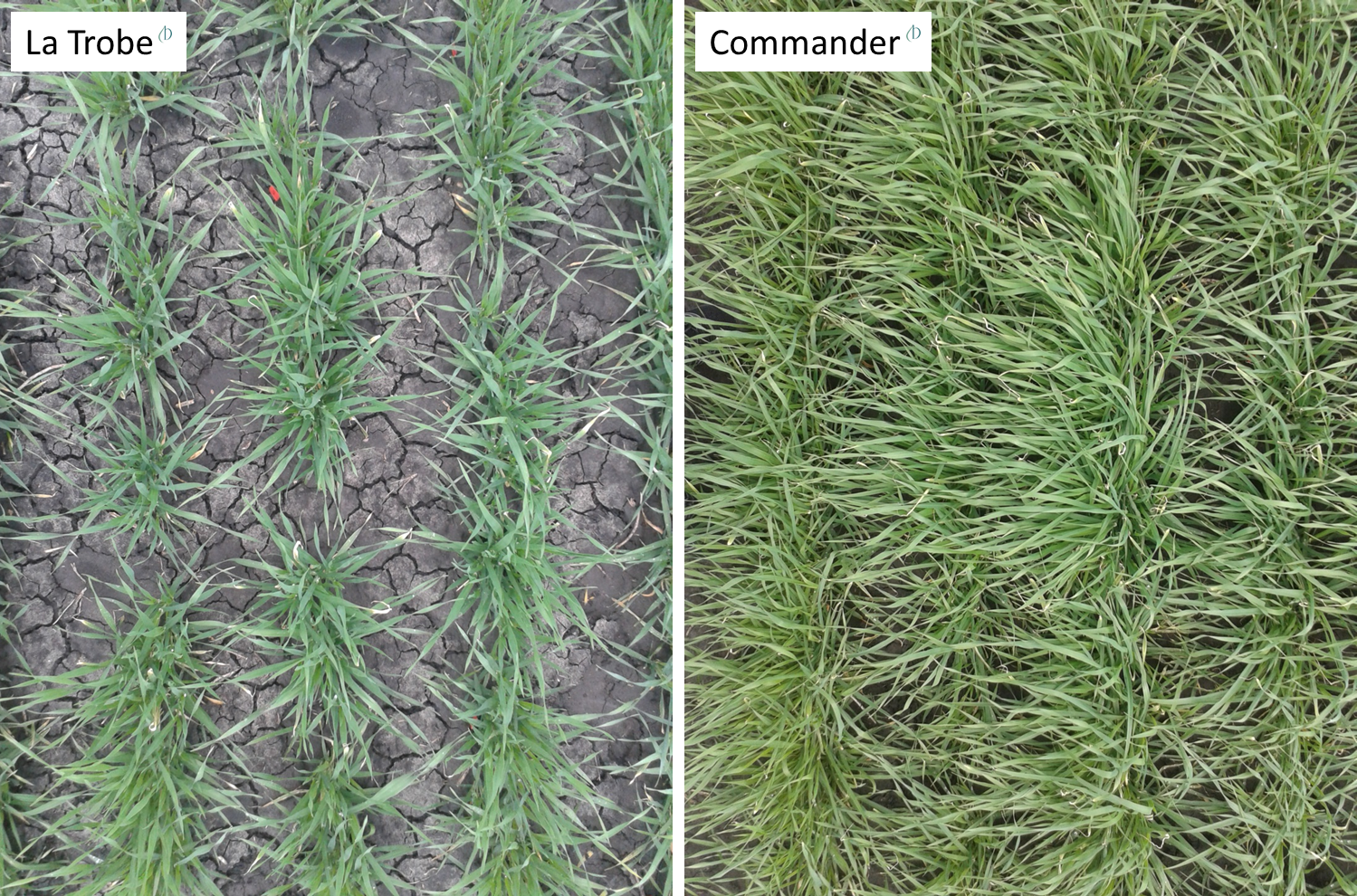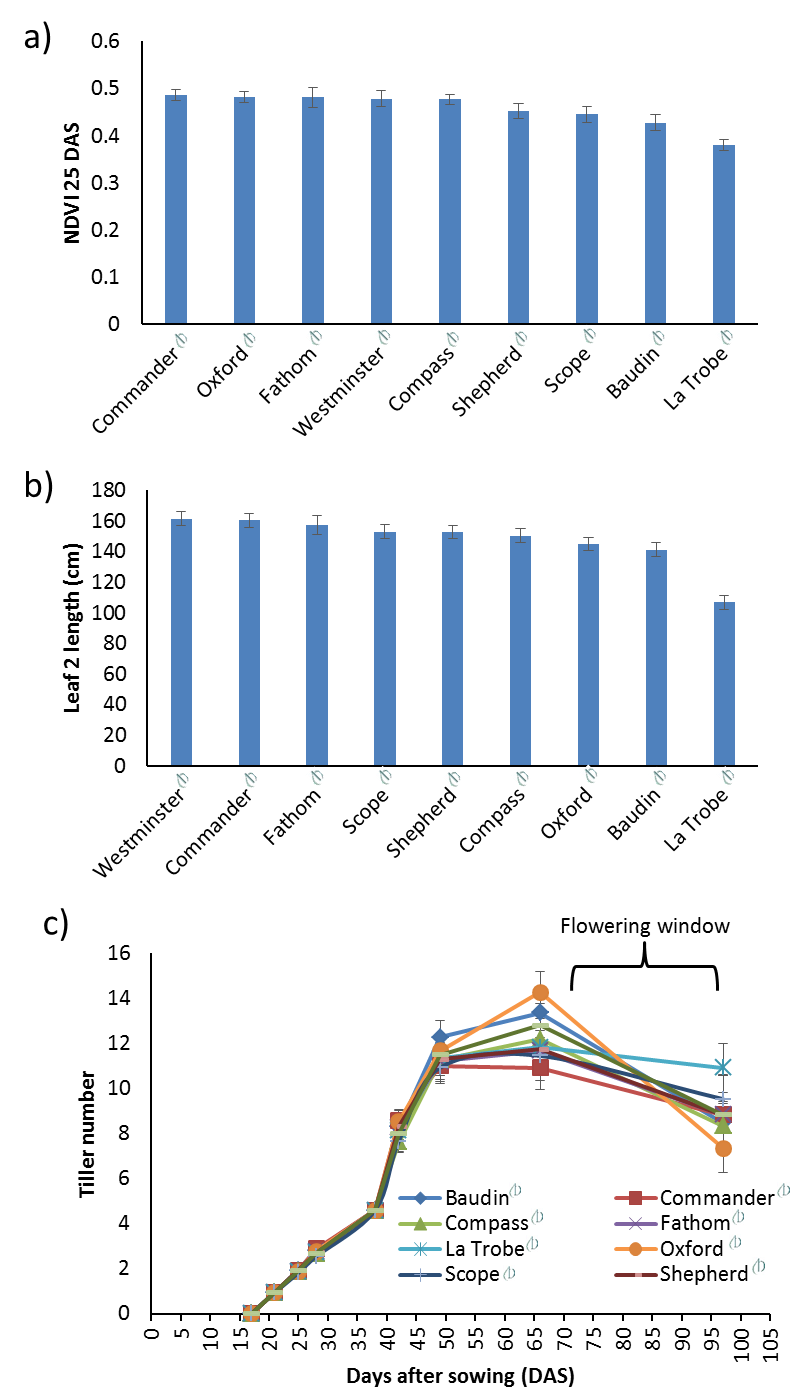Variation for early vigour in commercial barley varieties
Author: Lee Hickey(1), Cameron Van-Lane(1),(2), Hannah Robinson(1), Ian Godwin(2), Andrew Borrell(3) | Date: 27 Feb 2017
Take home messages
- Early vigour may be a useful trait to improve water-use efficiency and weed competitiveness.
- Significant variation for early vigour was observed among commercial barley varieties.
- Early tiller production was not a major component of early vigour, but rather the dimensions of the first two leaves, which were correlated with NDVI at 25 days after sowing.
- The length of the second leaf may provide a useful proxy trait to enable selection for early vigour in barley breeding programs.
Background
Early vigour, defined as the rapid development of leaf area during early growth, has been identified as a desirable trait for cereal crops in Mediterranean climates (Oosterom & Acevedo 1992; Bort et al. 1998). Vigorous early leaf growth in climates which experience late drought reduces evaporative water loss by shading the soil surface from direct solar radiation, allowing more water to be available for crop transpiration (Siddique et al. 1990). However, if early growth is excessive in a terminal drought, insufficient water may be available to optimise grain-filling (Borrell et al., 2014). Cooler temperatures and a low vapour pressure deficit early in the growing season also improve crop transpiration efficiency (Botwright et al. 2002). Overall, early vigour may improve water-use efficiency and enable drought avoidance. Early vigour also provides other agronomic benefits, such as improved phosphorus uptake and acquisition efficiency, especially in P-limited environments (Ryan et al. 2015); improved nitrogen uptake (Liao et al. 2004); and enhanced weed competitiveness (Bertholdsson 2005).
Based on research conducted by Lopez-Castaneda et al. (1996), barley was found to have the highest early vigour of temperate cereals. Despite this promise, wheat has been the subject of most research, which consistently indicates that early vigour is highly correlated with embryo size, width of leaves one and two, and that these traits display a high degree of heritability (Maydup et al. 2012; Moore & Rebetzke 2015). Until now, little is known about early vigour in barley.
This study aimed to explore the variation for early vigour and its underlying component traits in a collection of commercial barley varieties widely grown throughout Australia.
Investigating early vigour in Australian barley cultivars
For this study, a selection of malting and feed barley varieties currently grown throughout Australia were evaluated for early vigour, including: Commander, Oxford, Fathom, Westminster, Compass, Shepherd, Scope, Baudin and La Trobe. A field experiment was established at Hermitage Research Facility, Warwick, Queensland in 2016. The total in-season rainfall at this site was 320mm.
The normalized difference vegetative index (NDVI) was monitored for the first six weeks of crop growth using a hand-held NTech GreenSeeker®. This enabled an objective and non-destructive measure of leaf area and ground coverage. To investigate contributing component traits of early vigour, leaf dimensions were also recorded for the first two leaves at 25 days after sowing (DAS; Figure 1) and tiller production was monitored at regular intervals until anthesis.

Figure 1. Component traits of early vigour in barley. Featured plant was sampled 25 days after sowing at the field trial conducted at Hermitage Research Facility, Warwick, Queensland. Early tillers emerged in the axils of leaf 1 and leaf 2.
Differences among the barley varieties for NDVI were clearly differentiated at 25 DAS, reflecting variation for early vigour. For instance, the highest mean NDVI was obtained by Commander, while La Trobe obtained the lowest mean NDVI (Figure 2; Figure 3a). Other varieties that displayed high NDVI scores were Oxford, Fathom, Westminster and Compass. The broad-sense heritability for NDVI at 25 DAS was reasonably high (0.67), indicating that measures were quite consistent for the varieties examined in the trial.

Figure 2. Aerial view captured 25 days after sowing for Australian barley varieties: La Trobe (low early vigour) and Commander (high early vigour).
A higher degree of genotypic variation was observed for the length of the second leaf compared to width and dimensions for the first leaf. Through analysis of a larger panel of barley breeding lines, including the nine varieties examined in this report, we found a significant positive correlation between the length of the second leaf and NDVI measured at 25 DAS (r2 = 0.67). Therefore, leaf size, in particular the length of the second leaf, appears to be a major indicator of early vigour in barley and perhaps a useful proxy trait for selection in breeding programs.
Tiller number, on the other hand, showed very little variation among the varieties at 25 DAS and seems to contribute little to differences in NDVI at this stage (Figure 3c). Tiller number at 25 DAS was also extremely variable – with low heritability (0.097). However, as the crop approached anthesis, there were clear differences in the tillering behaviour for some barley varieties (Figure 3c). At time of anthesis, Oxford displayed the highest tiller number. Notably, Oxford also displayed high NDVI at early growth stages. However, this trend was not consistent. For instance, Commander displayed the highest NDVI at 25 DAS, but displayed the lowest tiller number at time of anthesis (Figure 3c).

Figure 3. Dissection of early vigour traits in barley varieties grown at Warwick in 2016, including: a) NDVI at 25 days after sowing (DAS), b) length of the second leaf, and c) development of tillers approaching anthesis. The best linear unbiased predictor (BLUP) for each variety is presented and error bars display the standard error.
Conclusions
Overall, barley varieties widely grown in Australia displayed significant variation for early vigour. Using NDVI, we were able to objectively differentiate the varieties according to the degree of plant biomass produced early in crop development. Furthermore, we were able to identify the length of the second leaf as a major indicator of early vigour in barley. The length of the second leaf may provide a useful proxy trait to enable selection for early vigour in barley breeding programs. High early vigour in barley likely has numerous benefits, including reduced evaporative losses and improved competition against weeds. But, in this study it was not possible to measure the direct effect of early vigour on yield due to a small sample size and significant variation for other traits that also contribute to final yield among the varieties (e.g. time to anthesis and different plant height genes). Thus, current research is focussed on evaluating larger populations that are purposely designed for genetic mapping and trait dissection. Evaluation of such material across diverse environments will hopefully generate the data to determine the value of early vigour in different production scenarios.
References
Bertholdsson, N. (2005). Early vigour and allelopathy – two useful traits for enhanced barley and wheat competitiveness against weeds. Weed Research, 45(2), 94-102.
Borrell, A.K., Mullet, J.E., George-Jaeggli, B., van Oosterom, E.J., Hammer, G.L., Klein, P.E. and Jordan, D.R. (2014). Drought adaptation of stay-green in sorghum associated with canopy development, leaf anatomy, root growth and water uptake. Journal of Experimental Botany 65 (21): 6251–6263.
Bort, Araus, Hazzam, Grando, & Ceccarelli. (1998). Relationships between early vigour, grain yield, leaf structure and stable isotope composition in field grown barley. Plant Physiology and Biochemistry, 36(12), 889-897.
Botwright, T., Condon, A., Rebetzke, G., & Richards, R. (2002). Field evaluation of early vigour for genetic improvement of grain yield in wheat. Australian Journal of Agricultural Research, 53(10), 1137.
Moore, C., Rebetzke, G. (2015). Genomic Regions for Embryo Size and Early Vigour in Multiple Wheat (Triticum aestivum L.) Populations. Agronomy (Basel), 5(2), 152-179.
Liao, M., Fillery, I., & Palta, J. (2004). Early vigorous growth is a major factor influencing nitrogen uptake in wheat. Functional Plant Biology, 31(2), 121-129.
Lopez-Castaneda, C., Richards, R.A., Farquhar, G.D., & Williamson, R.E. (1996). Seed and seedling characteristics contributing to variation in early vigor among temperate cereals. Crop Science, (5), 1257-1266.
Maydup, M., Graciano, C., Guiamet, J., & Tambussi, E. (2012). Analysis of early vigour in twenty modern cultivars of bread wheat ( L.). Crop and Pasture Science, 63(10), 987-996.
Oosterom, E., & Acevedo, J. (1992). Adaptation of barley ( Hordeum vulgare L.) to harsh Mediterranean environments. Euphytica, 62(1), 15-27.
Ryan, P., Liao, M., Delhaize, E., Rebetzke, G., Weligama, C., Spielmeyer, W., & James, R. (2015). Early vigour improves phosphate uptake in wheat. Journal Of Experimental Botany, 66(22), 7089-7100.
Siddique, K.H.M., Tennant, D., Perry, M.W., & Belford, R.K. (1990). Water use and water use efficiency of old and modern wheat cultivars in a Mediterranean-type environment [barley; Merredin, Western Australia]. Australian Journal of Agricultural Research, (3), 431-447.
Acknowledgements
We give thanks to the field staff of the Department of Agriculture and Fisheries at Hermitage Research Facility for assisting with field trials conducted as part of this study. The research forms part of a Grains Industry Undergraduate Honours Scholarship for Cameron Van-Lane, which was made possible by the significant contributions of growers through the GRDC and the authors would like to thank them for their continued support.
Contact details
Dr Lee Hickey
Queensland Alliance for Agriculture and Food Innovation
Ph: 07 3365 4805
Mb: 0408210286
Email: l.hickey@uq.edu.au
Varieties displaying this symbol beside them are protected under the Plant Breeders Rights Act 1994.
® Registered trademark
GRDC Project Code: UHS9174842,
Was this page helpful?
YOUR FEEDBACK
